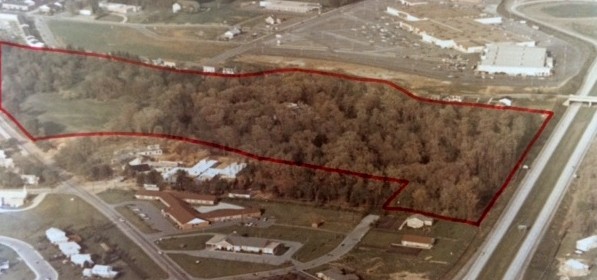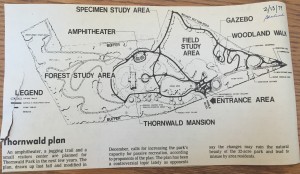Timeline | Thornwald Estate | Public Ownership| Debate over use | Converted mansion into retirement home | Dedication of Thornwald Park |The amphitheater | The land | Historical Resources|Photo Gallery
The Land:
The land of Thornwald park began as the fifty-three acer estate of Lewis Sadler accompanying his grand mansion built 1909-11. Sadler purchased forty-six acres of land from Joseph W. Noble and seven more acres from George H. Stewart. During the time of the Sadler’s inhabitancy of the estate, within the surrounding brick walls, the vast majority of the property consisted of gardens and wooded areas “resembling the estate of an English noble” (1). The gardens were said to be a mix of all kinds of plants and flowers so that of most of the year something was in bloom. Records state the presence of Rhododendrons, ivy, holly, forsythia, peonies and sweet peas, all arranged to give a sense of natural formality. This was the picture during the time of the Sadler estate, accompanying the many plants was a nine hole golf corse, wooded areas and a green pasture lawn. all of which were connected through interweaving pathways(1).
As time progressed the Thornwald fifty-three acres of land was divided into certain portions to serve different needs. In May of 1953 when Horace Sadler sold the estate to The Evangelical Reformed church, the church used the mansion as a retirement home and the grounds accompanied it. However in 1955 the Church took 11 acres of the land and built a new modern facility of their nursing home called Thornwald Home (3). The church then sold the land to the Carlisle School District in 1972.
The school board intended to build a middle school on the sight but was met with controversy from the public, hashing to keep the area as natural as possible. The board then decides to sell the remaining thirty-four acres of the original estate to the Carlisle Borough in 1975. The borough then on August 15, 1976, Dedicated the land as Thornwald Park to be used by the public of Carlisle(2/4).
As depicted in the image above, the park was planned for passive recreation. Features include an amphitheater, a trail, a visitors center, and a gazebo. A reoccurring debate came up from opponents concerned about the natural beauty of the park being taken away (5).
(1) Hertzler, John Vernon Jr., “Thornwald” First Reformed Church and Youth Department, 1952
(2) Paul Riede, The Evening Sentinel, The Scope, 1981, Cumberland County Historical Society
(3) UCC homes. org (Thornwald homes)
(4) Thornwald dedication pamphlet, Sunday August 15, 1976, Cumberland County Historical Society
(5) Thornwald Plan, The Sentinel, February 13, 1979, Carlisle Parks and Recreation Department.


